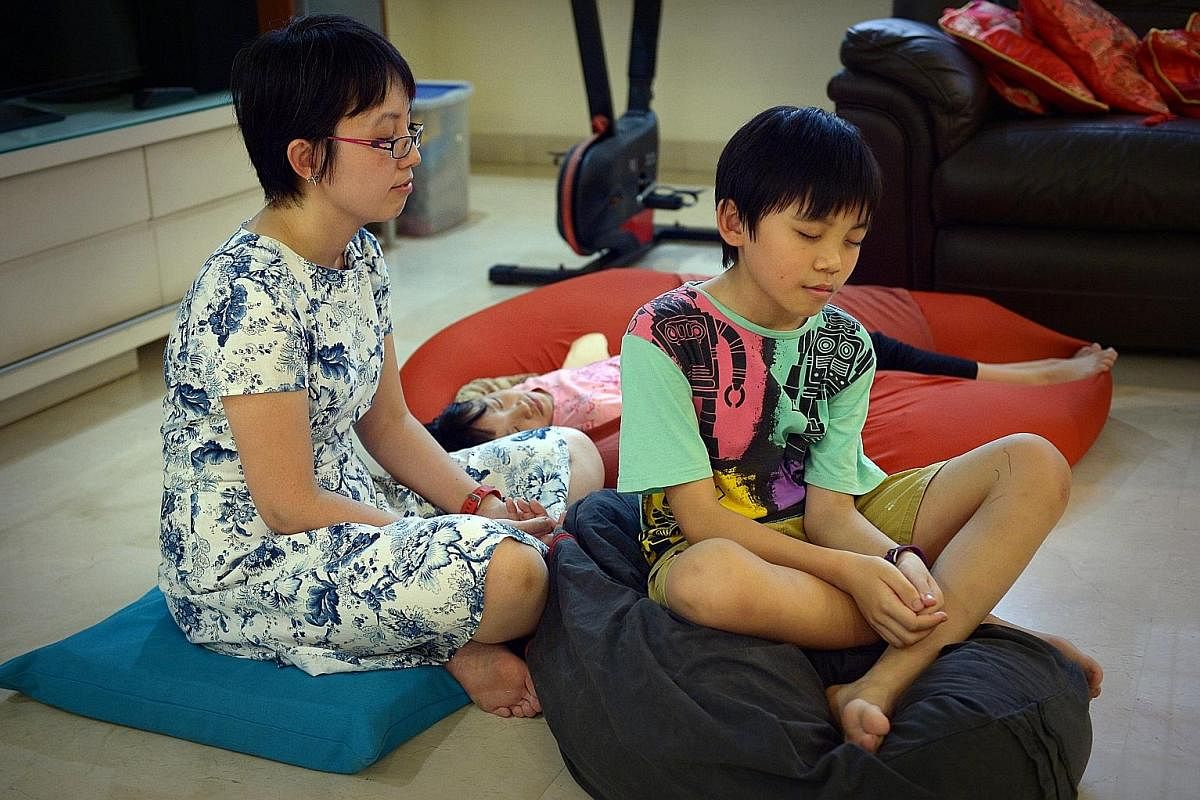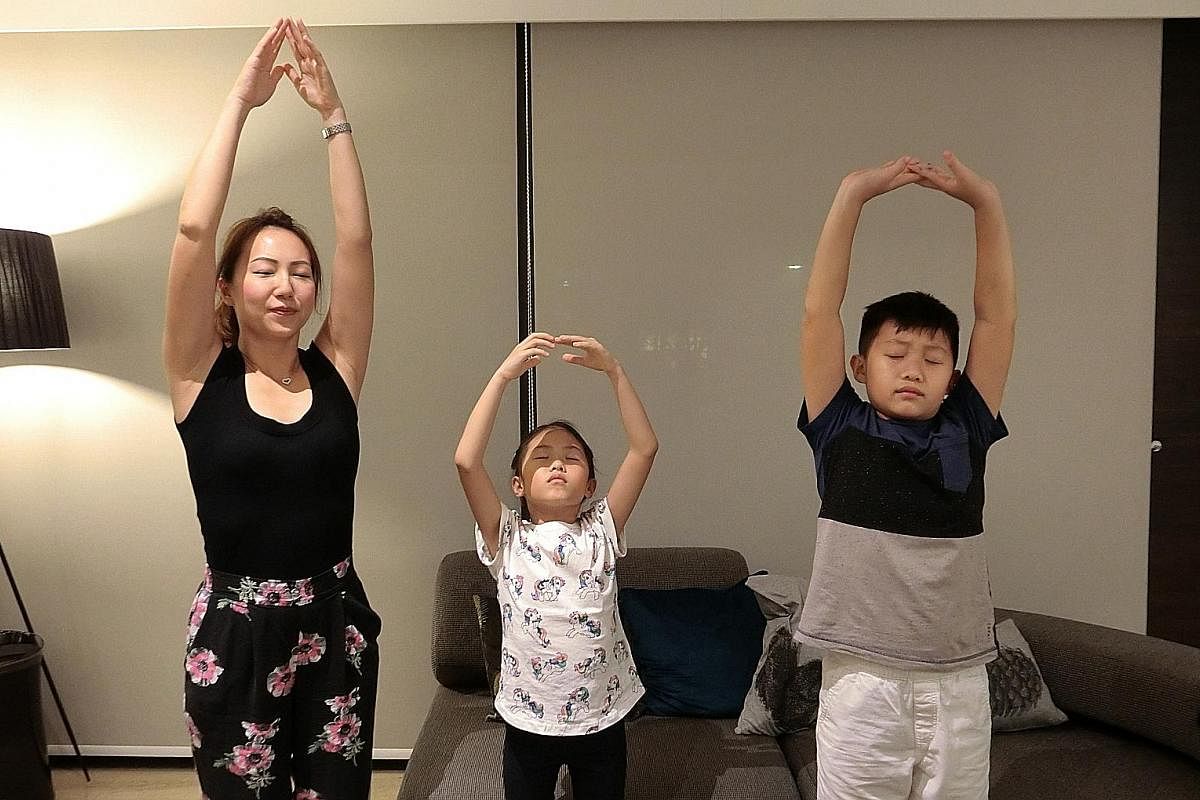How these children deal with stress
Helping children cope with stress: Meditate...and breathe
Teaching children to practise mindfulness can help them reduce stress and improve concentration, say health experts


Gautam Venkatraman found it hard to keep his eyes closed when he first started meditating at the age of seven.
"I kept blinking or opening my eyes. Now, I can do five minutes straight," says the nine-year-old.
He was taking part in a workshop two years ago that taught children about mindfulness.
Mindfulness is defined as a form of awareness of the present moment. Meditation and breathing exercises are among the techniques that can bring about this heightened awareness.
There are overlaps between mindfulness, meditation and yoga, which can be confusing. Some centres offer versions of all three, while some specialise in one area.
Proponents say the practice of mindfulness has benefits, such as reducing stress and improving concentration in an environment filled with smartphones, gadgets and other distractions. For children, it can be a relief from academic pressure at school.
These days, Gautam, who is a student at an international school, practises mindfulness to focus better when he plays tennis.
When he is aware of negative thoughts, he deliberately takes a mental pause to calm himself and think more positively.
"A lot of times, in tennis, when you're losing, you have to calm down and get back into the game. I don't think about the points lost. I think ahead," says Gautam.
He took the mindfulness workshop with his 13-year-old sister, Sashwika, on the advice of their mother, life-skills trainer Vidhya Shailesh, 40, who also does meditation.
While mindfulness is increasingly a buzzword for adults who go for such training in their personal and professional lives, some parents are enrolling their kids in such courses.
Purported benefits include being better poised to handle conflict and stress in school, during sports matches and in the playground.
How can children practise mindfulness when even adults often find it difficult to understand and practise?
In teaching mindfulness to children, "you take it in steps", says Mr Vikas Malkani. He is the founder of SoulCentre Academy, a centre for meditation and mindfulness for organisations, adults and children. The centre teaches children as young as six.
He says: "The first thing to do is engage the children. We get them interested by giving them real-life examples, such as actor Hugh Jackman, who plays Wolverine in the X-Men movies. He meditates regularly."
"We keep it fun for the children with stories, anecdotes, jokes and other activities."
START WITH JUST 30 SECONDS
Ms Mallika Kripalani, founder and director of The Conscious Zone, which helps adults, children and adolescents learn mindfulness, says a child can start off with 30 seconds of breathing exercises, in which they are asked to pay attention to their chest rising or feel their breath going in and out.
"You want to make sure you create a safe space for everyone who's present. I've had kids in my class who don't want to close their eyes or who need to fidget or move a little. It takes time," she says.
"If a child knows how to breathe mindfully, it helps him calm down quickly and to break the cycle of anxiety, anger or frustration when he's having a tantrum."
She adds that many parents who enrol their children in her mindfulness workshops are keen to get their kids to calm down or focus better in areas such as test-taking, sports, ballet and playing the piano.
"The boost that mindfulness brings to this performance aspect appeals to some parents," she adds.
Dr Lim Boon Leng, a psychiatrist at Gleneagles Hospital, says there has been research that shows meditation or mindfulness therapy can improve the regulation of emotions. "The amygdala, the part of the brain that is associated with fear or anxiety, is less activated following mindfulness therapy," he says.
Siblings Leon and Isabel Loh agree that practising mindfulness has helped them in anxious or frustrating situations.
To calm down before his Chinese oral examination, which he is not that confident about, Leon, nine, says he does starfish meditation beforehand, in which the fingers are spread out like a starfish on one hand. He concentrates on using a finger from the other hand to trace the "starfish", focusing on breathing in and out.
Isabel, seven, says: "You don't feel so stressed if your friend fights with you. You take three breaths and you know you shouldn't say anything bad back to her."
Dr Sam Han, a sociologist at Nanyang Technological University, says mindfulness practices in offices and schools around the world "promise a kind of restoration when people are exhausted and feel pressure to be more productive".
However, he says the focus on mindfulness seems to place the burden of stress reduction "on the individual as opposed to institutions in society".
When it comes to removing sources of stress in the workplace or in the education system, for instance, there are many stakeholders who should be involved in addressing such "multi-faceted" problems, he says.
"While mindfulness gives students another resource to deal with this, it should be a leg of the chair and not the whole chair," he says.
There are other precautions when it comes to teaching mindfulness, especially to children.
Dr Gregor Lange, deputy director, head of learning and development at National University of Singapore's Centre for Future-ready Graduates, says mindfulness teachers should not sell their services as "a panacea for all problems".
"It is important to understand the limitations. For instance, children with Asperger syndrome, ADHD (attention deficit hyperactivity disorder) or other behavioural or mental-health issues should be referred to psychologists or psychiatrists for an assessment," says the trained psychologist.
Dr Lim says it is advisable to seek professional help if one has mental illness such as depression, in which the treatment has to be tailored to the individual.
Parents who enrol their children in mindfulness programmes sometimes take up mindfulness training too.
Ms Angie Chew, executive director and principal mindfulness trainer at Brahm Centre, which promotes happier and healthier living, says: "If children learn mindfulness on their own, it is hard for the impact to be sustainable if the parents provoke them by nagging or always talking down to them.
"Parents need to practise mindfulness just as much as the child. You can't expect the child to be calm if the parent is always kancheong (a Singlish term for uptight and anxious)."
Since their family of four took a mindfulness workshop together last year, Leon and Isabel have been practising breathing and other mindfulness techniques with their parents, stay-at-home mum Lim Yu Lin, 39, and Mr Loh Sze-Wei, 43, a manager in the oil and gas industry.
Ms Lim says mindfulness helps them appreciate simple pleasures, such as having dinner together.
She adds: "I wanted us to communicate better as a family, with more impulse control. We still get mad... but at least we understand there's a better way to deal with it."
Schoolboy finds way to deal with bullying
Practising mindfulness played a part in helping Ho Jon Yew, 10, deal with the bullying he faced during a large part of his school years.
From the time he was in Primary 1, Jon Yew, now in Primary 5, had trouble concentrating on his work and found it hard to mix with other kids. He was the subject of teasing and had meltdowns, says his mother, Dr Koh Li Wearn, 42, who is married to another doctor. The couple have a younger daughter, Jean Anne, aged seven.
It was distressing as they wondered how to help their son, whom they sent for medical tests, says Dr Koh. But Jon Yew was not diagnosed as having any medical issues.
A friend told her about a mindfulness-based book, Search Inside Yourself, written by Singaporean Chade-Meng Tan, a former Google engineer, which Dr Koh read and found helpful.
She also remembered how she had gone with her mother for regular Buddhist meditation sessions during her secondary school days.
The family went for a mindfulness workshop last year and has been practising meditation techniques. At night, she tries to get the children to do breathing exercises for two minutes, beyond which they have a tendency to get restless, she says.
Dr Koh practises mindfulness every day - during lunchtime and on her 10-minute walks to and from work.
Being mindful of her thoughts, emotions and surroundings recharges her and has made her more calm during her work day, she says.
Jon Yew says meditation has helped him deal with the teasing.
"I think it's quite useful in school, before sitting an exam and whenever I get teased, to stop myself from crying or arguing. I can breathe consciously and walk away. But it doesn't work all the time."
Dr Koh says Jon Yew's teachers have also been supportive and intervened to ease the situation at school.
She says mindfulness takes time and is not a miracle solution.
"He's managed to gain enough self-confidence by not reacting to the teasing," she adds.
Tips on how to get started
Ms Mallika Kripalani, founder and director of The Conscious Zone, which helps adults, children and adolescents learn mindfulness, gives tips on getting children to practise mindfulness: "It takes time for children to learn mindfulness. I tell parents to be patient and model the practice for them.
For a child of about four or five years old, you can ask him to put a cuddly toy on his stomach and lie down and watch the toy rise up and down as he breathes.
The child starts to develop the sense of paying attention, bringing focus to one thing. This helps with regulating emotions. Such simple breathing techniques, practised when a child is calm, can be used in future stressful situations.
You can also try mindful listening with a child, in which he closes his eyes and hears the different sounds in his environment.
With mindful eating, you can ask a child to observe an orange using his five senses.
Mindfulness brings one back to the present moment. People tend to think they should have done something better in the past or about future tasks, such as sending e-mail messages later in the day.
Living one's life in the here and now helps one to be aware of what one is feeling and also what others may feel.
You realise that emotions are transient. With training, you can see patterns that can help you change habitual behaviours.
Besides being calming and de-stressing, it promotes resilience and compassion."
Join ST's Telegram channel and get the latest breaking news delivered to you.
A version of this article appeared in the print edition of The Sunday Times on November 12, 2017, with the headline Helping children cope with stress: Meditate...and breathe. Subscribe

